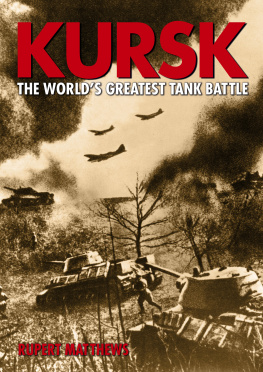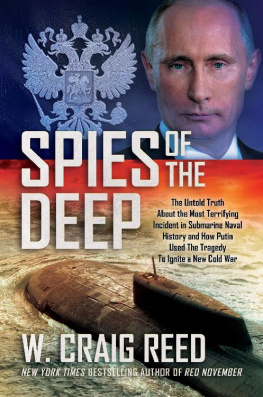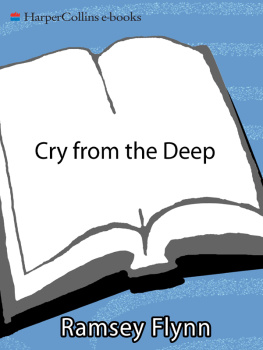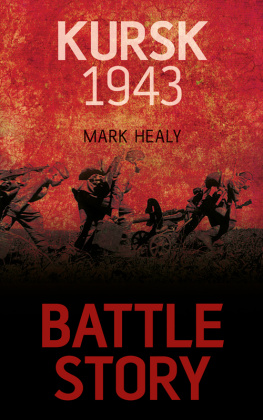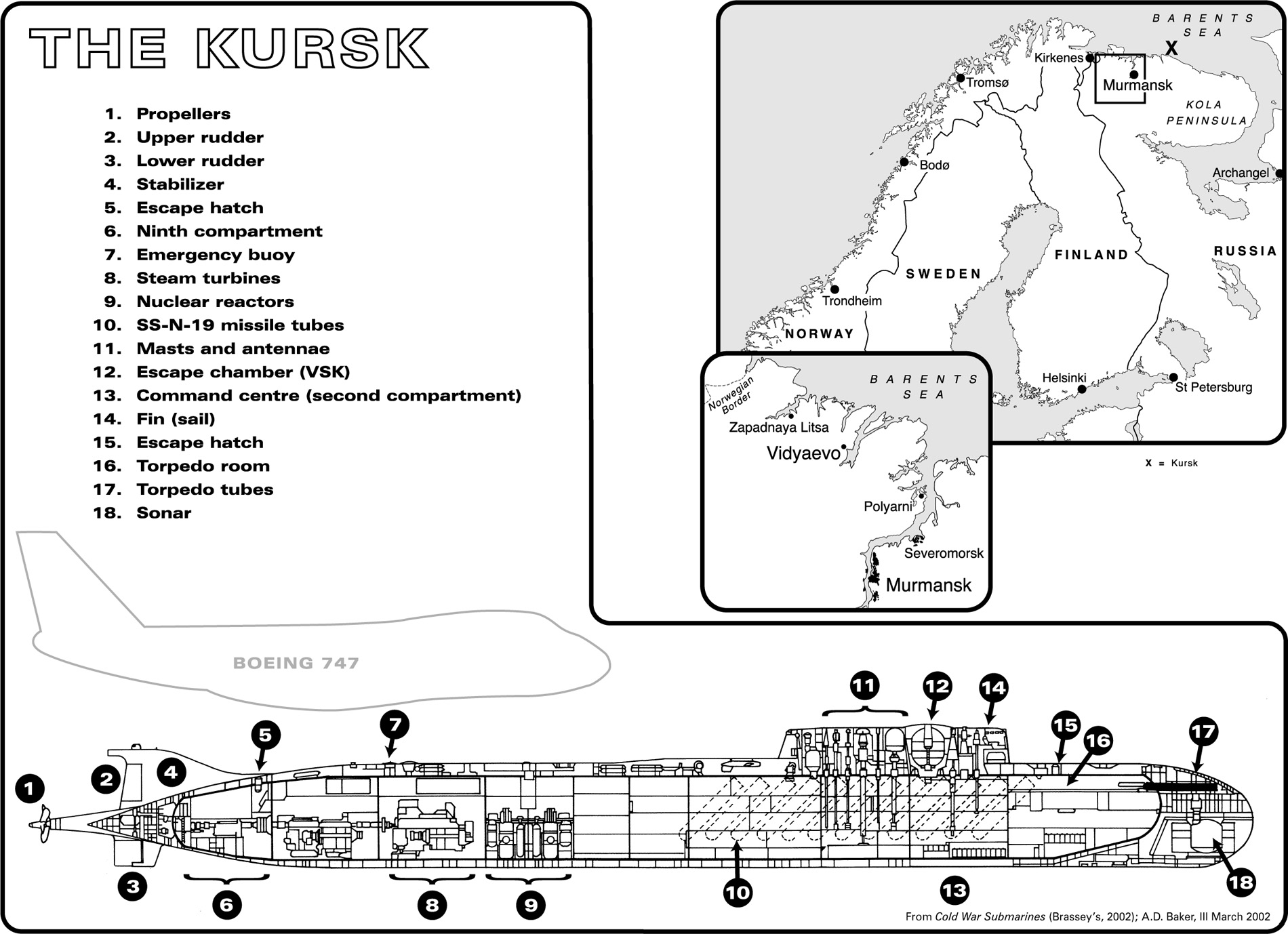About the Book
The acclaimed and harrowing story of the fate of Russias most powerful submarine now with new material from the author.
At 11.28 a.m. on Saturday, 12 August 2000, a massive and mysterious blast punched through the shallow Arctic waters of the Barents Sea. 135 seconds later, another colossal explosion was detected by seismologists around the globe. The Kursk, pride of Russias Northern Fleet and the largest attack submarine in the world, was plunging to the ocean floor, fatally wounded.
In Kursk, award-winning television journalist Robert Moore vividly recreates this disaster minute by minute. Venturing into a covert world where the Cold War continues out of sight, Moore investigates the military and political background to the tragedy. But above all, he tells the nail-bitingly poignant human story of the families waiting on shore, of the desperate efforts of the British, Norwegian and Russian rescuers, and of the twenty-three sailors, trapped in the aft compartment of the stricken submarine, waiting for rescue, as a horrified world followed their fight to stay alive
It takes you through each nail biting moment, willing it to turn out differently. Heartbreaking, humane and, at times, all too vivid. Ive rarely read such a gripping work of non-fiction
Colin Firth
The Kursk was once the pride of the Russian navy and a symbol of state power her story, harrowingly detailed stands as a testament to the bravery and loyalty of men to a nation that failed them
Orlando Figes, The Times
A revised and updated edition of the book previously published as A TIME TO DIE
Contents
International acclaim for the original edition, A Time to Die:
What is striking is the human tragedy: the bravery of the crew, the effect of the tragedy on those ashore, the dramatic and doomed rescue attempts and the chilling fate of the 23 survivors of the initial explosion Harrowingly detailed
The Times
[Moore] has made good use of his experience as a journalist and his contacts to write a gripping account that reads in parts like a well-researched thriller
Times Literary Supplement
Robert Moores account of the Kursk is a gripping tale a moving tragedy redeemed by acts of extraordinary courage, which Moore narrates with great dramatic skill. The book has the plot, the tension and the excitement of a film
Sunday Telegraph
Moore [tells] a compelling story, making vivid the experiences of the submariners, their families and the many men Russian, Norwegian, and British, military and civilian who strove to save them. His description is clear and excruciating; the possibility of life inside the hull is palpable in these pages
Evening Standard
This is an emotion-packed and ultimately heartbreaking story that also sheds light on the Soviet militarys decline The tragedy was a telling example of how the Soviet legacy still lingers Moore provides a vivid account of the last desperate attempts to open the hatch (his) narration is fast-paced
Washington Post
A Time to Die is remarkable for its subject matter and style. This true account of the peacetime, accidental loss of a submarine and her crew is written in the tight, lean style that exemplifies excellent journalism This tale is expertly narrated and the storys excitement and drama persist through straightforward and unadorned language
Associated Press
This is a classic race-against-time story, mixed with underwater espionage, individual heroism, harrowing attempts at rescue and Soviet-style secrecy. Robert Moore is a journalist with years of experience in Russia and it shows meticulously investigated
Globe & Mail (Toronto)
A harrowing account of the disaster the result is a gripping read, written in the style of a thriller, which serves as a fitting memorial to the lost sailors and as an indictment of Russias military and political leaders The book crackles with the authority of two years solid research
New Zealand Herald
Maybe the most amazing feat involving the Kursk is that Moore has been able to put the whole story together clinical in its detachment and poignant in its humanity
Rocky Mountain News
With this gripping account of the Kursks death Moores incisive journalistic approach will remain the best English-language account of this event for some time
Publishers Weekly
A fast-paced and absorbing account of the 2000 sinking of the Kursk and the political intrigue that followed a fine job of reporting and a good read for Tom Clancy fans and students of contemporary world politics alike
Kirkus Reviews
www.penguin.co.uk
KURSK
Putins First Crisis and the Russian Navys Darkest Hour
Robert Moore
To the crew of K-141 and the extraordinary families they left behind, especially the seventy children
And to Liz, Timothy, Freya and Claudia for their inspiration
Of all the branches of men in the forces there is none which shows more devotion and faces grimmer perils than the submariners.
W INSTON C HURCHILL
Foreword
On 12 August each year, at Russian naval bases from Vladivostok to Kaliningrad and from Murmansk to Sevastopol, and aboard ships of all four Fleets, officers and recruits stand at attention and observe a moment of silence. In many garrisons, an Orthodox priest leads a short memorial service, with incense floating in the summer air, and a melodic chant audible across the parade ground. The blue and white Andreyev flag of the Russian Navy flies at half-staff.
Entirely out of view, below the surface of Russias seas and beyond, the sailors of the submarine flotillas also pause at their posts to remember lost comrades.
The most poignant memorial service takes place in St Petersburg, the magnificent Baltic port that has been the spiritual home of the Russian Navy since the citys founding in 1703. At the Serafmovskoye cemetery, families hold each other for comfort. Children gather around the graves of fathers they never knew or can barely remember. Widows and mothers place red roses beside the headstones. The graveyard is best known as the burial site for the countless thousands who died of cold and starvation in the Great Siege of Leningrad of 1941, but it also holds other patriots and military heroes from the nations tumultuous past.
This is the final resting place for thirty-two sailors of the Kursk, who boarded their submarine on a calm midsummers day in 2000 for a short training exercise in Arctic waters and who never again saw the Russian Motherland. Among those buried here is the commanding officer of the submarine, Captain Gennady Lyachin. Each headstone has a portrait of the sailor etched into black marble.
In total, 118 sailors died aboard the Kursk, the most humiliating naval disaster for Russia since the Second World War. The eighty-six submariners not buried in St Petersburg rest in cemeteries scattered across Russia, mostly in hometowns where they grew up.
The headstones have the date of death marked as 12.08.2000, the August day when twin explosions ripped through the submarine, killing most of those aboard within minutes. But the inscription for one of the sailors, Dmitri Kolesnikov, is the exception. There is no consensus, and considerable controversy, over when he died, so the date on the grave is written simply as 08.2000 with the exact day conspicuously absent.







